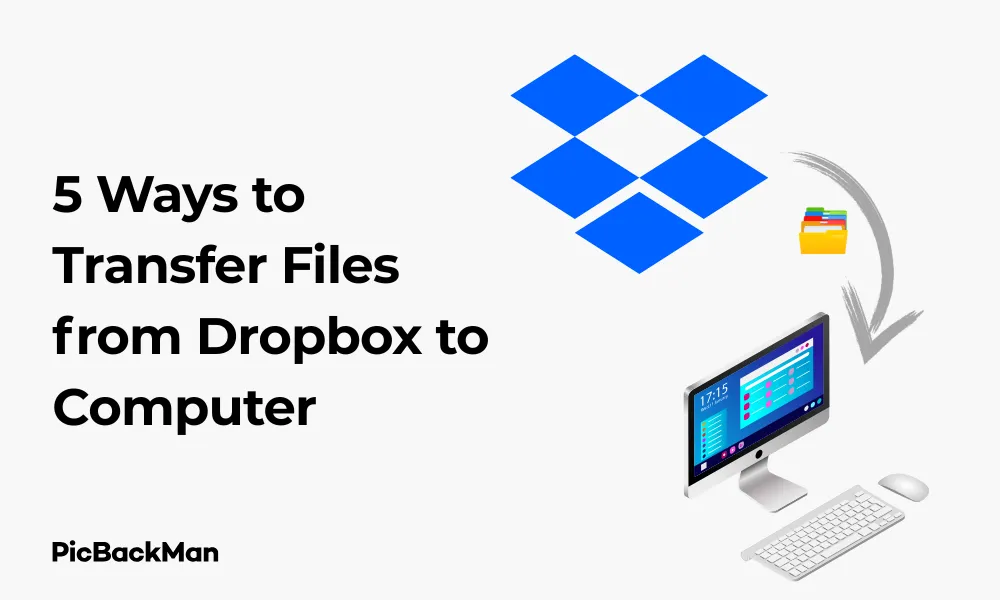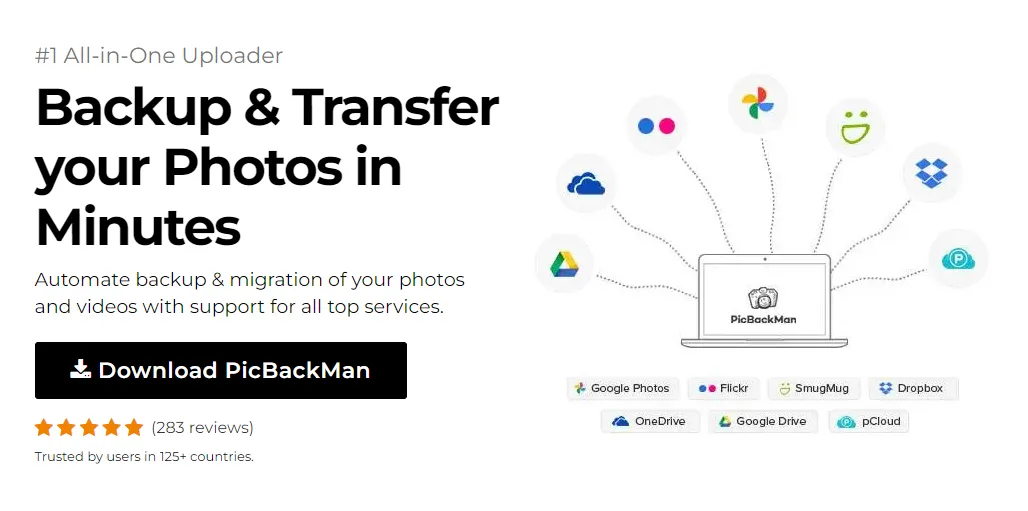
Why is it the #1 bulk uploader?
- Insanely fast!
- Maintains folder structure.
- 100% automated upload.
- Supports RAW files.
- Privacy default.
How can you get started?
Download PicBackMan and start free, then upgrade to annual or lifetime plan as per your needs. Join 100,000+ users who trust PicBackMan for keeping their precious memories safe in multiple online accounts.
“Your pictures are scattered. PicBackMan helps you bring order to your digital memories.”
5 Ways to Transfer Files from Dropbox to Computer


Need to get your files from Dropbox to your computer? You're not alone. Whether you're working on a project, backing up important documents, or simply organizing your digital life, knowing how to efficiently transfer files from Dropbox to your computer is an essential skill in today's digital world.
I've been using Dropbox for years, and I've tried every method to download my files quickly and easily. In this guide, I'll walk you through 5 practical ways to transfer your files from Dropbox to your computer, with step-by-step instructions that anyone can follow.
Method 1: Download files directly from the Dropbox website
The most straightforward approach to getting your files from Dropbox to your computer is using the Dropbox website. This method works on any computer with an internet connection, making it perfect when you're using someone else's device or a public computer.
Step-by-Step Guide to Download Files from Dropbox Website
- Open your web browser and go to www.dropbox.com
- Sign in to your Dropbox account using your email and password
- Navigate to the file or folder you want to download
- For a single file:
- Hover over the file and click the three dots (⋯) that appear on the right
- Select "Download" from the dropdown menu
- For multiple files:
- Check the boxes next to each file you want to download
- Click the "Download" button that appears in the top menu
- For an entire folder:
- Click on the folder to open it
- Click the three dots (⋯) in the upper right corner
- Select "Download" from the dropdown menu
The file(s) will download to your computer's default download location. Depending on your browser settings, you might be prompted to choose where to save the files.
Pros of Using the Dropbox Website
- No installation required
- Works on any computer with internet access
- Good for occasional downloads or when using public computers
Cons of Using the Dropbox Website
- Not ideal for transferring many files regularly
- Larger files or folders will be compressed into a ZIP file
- Requires stable internet connection throughout the download process
Method 2: Use the Dropbox Desktop App
For regular Dropbox users, the desktop app provides the most seamless experience. Once set up, it creates a special folder on your computer that automatically syncs with your Dropbox account.
How to Set Up and Use the Dropbox Desktop App
- If you don't have the Dropbox app installed:
- Go to www.dropbox.com/install
- Download the appropriate version for your operating system (Windows, Mac, or Linux)
- Run the installer and follow the on-screen instructions
- Sign in with your Dropbox credentials
- Once installed, the app creates a Dropbox folder on your computer
- Any files in your Dropbox account will automatically download to this folder
- To transfer specific files:
- Open the Dropbox folder on your computer
- Navigate to the files or folders you want to transfer
- Copy or move them to another location on your computer
Selective Sync Feature
If you don't want all your Dropbox files on your computer, you can use Selective Sync:
- Click the Dropbox icon in your system tray or menu bar
- Click your profile picture or initials
- Select "Preferences" (on Mac) or "Settings" (on Windows)
- Go to the "Sync" tab
- Click "Choose folders"
- Uncheck the folders you don't want to sync to your computer
- Click "Update"
Pros of Using the Dropbox Desktop App
- Automatic syncing keeps files updated on both your computer and Dropbox
- Access files offline once they've been synced
- No need to manually download files each time you need them
Cons of Using the Dropbox Desktop App
- Uses storage space on your computer
- Initial setup can take time if you have many files
- Requires installation (not ideal for public computers)
Method 3: Use Dropbox Smart Sync
Dropbox Smart Sync is a premium feature that allows you to see and access all your Dropbox files from your computer without using all your hard drive space.
Setting Up and Using Smart Sync
- Make sure you have a Dropbox Plus, Professional, or Business subscription
- Install the Dropbox desktop app as described in Method 2
- By default, new files will appear as "online-only" (they don't take up local storage space)
- To download a file to your computer:
- Right-click on the file in your Dropbox folder
- Hover over "Smart Sync"
- Select "Local"
- To make a file online-only again:
- Right-click on the file
- Hover over "Smart Sync"
- Select "Online-only"
Setting Default Sync Behavior
- Click the Dropbox icon in your system tray or menu bar
- Click your profile picture or initials
- Select "Preferences" or "Settings"
- Go to the "Sync" tab
- Under “Smart Sync,” choose your default setting for new files
Pros of Using Smart Sync
- Saves hard drive space while providing access to all files
- Files appear in your file explorer even when they're online-only
- Flexible control over which files are stored locally
Cons of Using Smart Sync
- Requires a paid Dropbox subscription
- Online-only files need internet access to open
- Opening online-only files takes longer than local files
Method 4: Use the Dropbox Mobile App to Transfer to Computer
Sometimes you might want to transfer files from your Dropbox to your computer while you're on the go. The Dropbox mobile app can help with this process.
Steps to Transfer Files Using the Mobile App
- Download and install the Dropbox app on your mobile device from the App Store or Google Play Store
- Sign in to your Dropbox account
- Navigate to the file you want to transfer
- Tap the three dots (⋯) next to the file
- Select "Export" or "Share"
- Choose one of these methods:
- Email the file to yourself and then open the email on your computer
- Use AirDrop (for iOS to Mac transfers)
- Use a messaging app that's also on your computer
- Use "Save to Files" (iOS) or "Save to Device" (Android) and then transfer via USB
Transferring via USB
- Save the files to your phone as described above
- Connect your phone to your computer using a USB cable
- On your phone, allow file access when prompted
- On your computer, open File Explorer (Windows) or Finder (Mac)
- Navigate to your phone's storage
- Find the downloaded files and copy them to your computer
Pros of Using the Mobile App Method
- Useful when you're away from your computer
- Multiple sharing options available
- Can work without installing anything on the computer
Cons of Using the Mobile App Method
- More steps involved than direct methods
- Not ideal for large files or multiple files
- May use mobile data if not connected to Wi-Fi
Method 5: Use Dropbox API or Third-Party Tools
For advanced users or those with specific needs, Dropbox offers an API that developers can use to create custom solutions. There are also many third-party tools that integrate with Dropbox to enhance its functionality.
Popular Third-Party Tools for Dropbox Transfers
MultCloud
- Go to www.multcloud.com and create an account
- Click "Add Cloud" and select Dropbox
- Authorize MultCloud to access your Dropbox
- Add your computer's cloud storage (like Google Drive or OneDrive)
- Use the "Cloud Transfer" feature to move files from Dropbox to your other cloud storage
- Download the files from your other cloud storage to your computer
Otixo
- Sign up at www.otixo.com
- Connect your Dropbox account
- Browse your Dropbox files through the Otixo interface
- Download files directly to your computer or transfer them to another connected cloud service
Using Dropbox API (for developers)
If you have programming skills, you can create custom scripts to transfer files using the Dropbox API:
- Register a new app in the Dropbox App Console
- Get your API key and access token
- Use a programming language like Python to write a script that downloads files
Example Python Script Using Dropbox API
import dropbox
import os
# Set your access token
TOKEN = 'your_access_token_here'
# Initialize Dropbox client
dbx = dropbox.Dropbox(TOKEN)
# Path in Dropbox to download
DROPBOX_FILE_PATH = '/path/to/file.txt'
# Local path to save the file
LOCAL_FILE_PATH = 'C:/Downloads/file.txt'
# Download the file
with open(LOCAL_FILE_PATH, 'wb') as f:
metadata, result = dbx.files_download(path=DROPBOX_FILE_PATH)
f.write(result.content)
print(f"Downloaded {DROPBOX_FILE_PATH} to {LOCAL_FILE_PATH}")
Pros of Using API or Third-Party Tools
- Highly customizable solutions
- Can automate repetitive transfer tasks
- Some tools offer additional features such as scheduling or encryption
Cons of Using API or Third-Party Tools
- May require technical knowledge
- Some third-party tools require payment
- Security concerns when granting access to your Dropbox
Comparison of All Methods
| Method | Ease of Use | Speed | Best For | Requirements |
|---|---|---|---|---|
| Dropbox Website | Easy | Medium | Occasional downloads, public computers | Internet connection, web browser |
| Desktop App | Easy | Fast | Regular users, multiple files | Installation permissions, disk space |
| Smart Sync | Medium | Fast | Limited disk space, large Dropbox accounts | Paid subscription, installation permissions |
| Mobile App | Medium | Slow | On-the-go access, no computer installation | Smartphone, possibly USB cable |
| API/Third-Party | Hard | Varies | Automation, custom workflows | Technical knowledge or third-party accounts |
Tips for Efficient File Transfers from Dropbox to Computer
Managing Large Files
- Break large files into smaller chunks before uploading to Dropbox
- Use compression (ZIP files) to reduce transfer time
- Consider using Smart Sync for very large files you don't need to access frequently
- For files over 10GB, the desktop app is usually more reliable than the website
Organizing Your Downloads
- Create a dedicated folder on your computer for Dropbox downloads
- Maintain the same folder structure on your computer as in Dropbox
- Use descriptive file names to easily find files later
- Consider using tags or categories in your file system
Troubleshooting Common Issues
Slow Downloads
- Check your internet connection speed
- Close bandwidth-heavy applications
- Try downloading at off-peak hours
- Consider using a wired connection instead of Wi-Fi
Failed Downloads
- Ensure you have enough disk space
- Try a different browser if using the website method
- Restart the Dropbox desktop app
- Check if your antivirus is blocking the download
Sync Issues with Desktop App
- Check the Dropbox status icon for any alerts
- Pause and resume syncing
- Sign out and sign back in to the app
- Reinstall the app if problems persist
Quick Tip to ensure your videos never go missing
Videos are precious memories and all of us never want to lose them to hard disk crashes or missing drives. PicBackMan is the easiest and simplest way to keep your videos safely backed up in one or more online accounts.
Simply download PicBackMan (it's free!) , register your account, connect to your online store and tell PicBackMan where your videos are - PicBackMan does the rest, automatically. It bulk uploads all videos and keeps looking for new ones and uploads those too. You don't have to ever touch it.
Security Considerations When Transferring Files
When transferring files from Dropbox to your computer, keep these security aspects in mind:
Protecting Sensitive Information
- Always log out of Dropbox when using public computers
- Consider encrypting highly sensitive files before uploading them to Dropbox
- Use strong, unique passwords for your Dropbox account
- Enable two-factor authentication for your Dropbox account
Safe Handling of Downloaded Files
- Scan downloaded files with antivirus software
- Be cautious with executable files (.exe, .dmg, etc.)
- Verify the source of shared files before opening them
- Keep your computer's operating system and security software updated
Conclusion
Transferring files from Dropbox to your computer doesn't have to be complicated. Whether you prefer the simplicity of the Dropbox website, the convenience of the desktop app, the space-saving benefits of Smart Sync, the mobility of the mobile app, or the customization of third-party tools, there's a method that will work for your specific needs.
For occasional transfers of a few files, the website method is quick and doesn't require any installation. For regular Dropbox users, the desktop app provides the most seamless experience. If you're concerned about storage space, Smart Sync offers an excellent compromise. Mobile users can leverage the Dropbox app to transfer files when away from their computers, and power users can explore API and third-party options for custom solutions.
By understanding these different methods and choosing the right one for your situation, you can make file transfers from Dropbox to your computer efficient, secure, and hassle-free. Remember to keep security in mind, especially when handling sensitive information, and organize your downloads to save time in the future.
Frequently Asked Questions
1. Can I transfer files from Dropbox to my computer without an internet connection?
No, you need an internet connection to transfer files from Dropbox to your computer for the first time. However, if you're using the desktop app and have already synced your files, you can access those files offline. The Smart Sync feature requires an internet connection to download online-only files.
2. Is there a limit to how many files I can transfer from Dropbox to my computer?
There's no limit to the number of files you can transfer, but there are practical limitations based on your Dropbox storage quota, your computer's available storage space, and your internet connection speed. Very large transfers might take a significant amount of time to complete.
3. Will transferring a file from Dropbox to my computer remove it from Dropbox?
No, transferring or downloading a file from Dropbox to your computer creates a copy of the file. The original file remains in your Dropbox account unless you specifically delete it. If you're using the desktop app, deleting a file from your Dropbox folder will also delete it from your Dropbox account.
4. How do I transfer files from my computer back to Dropbox?
You can upload files to Dropbox by dragging them into your Dropbox folder (if using the desktop app), or by clicking the “Upload” button on the Dropbox website and selecting the files you want to upload. The mobile app also has an upload feature for adding files from your phone to your Dropbox account.
5. Can I transfer files from someone else's Dropbox to my computer?
Yes, if someone has shared a Dropbox file or folder with you, you can download it to your computer. Access the shared content through the “Shared” section of your Dropbox account, then use any of the download methods described in this article. If someone sent you a Dropbox sharing link, you can download the file directly from that link.






